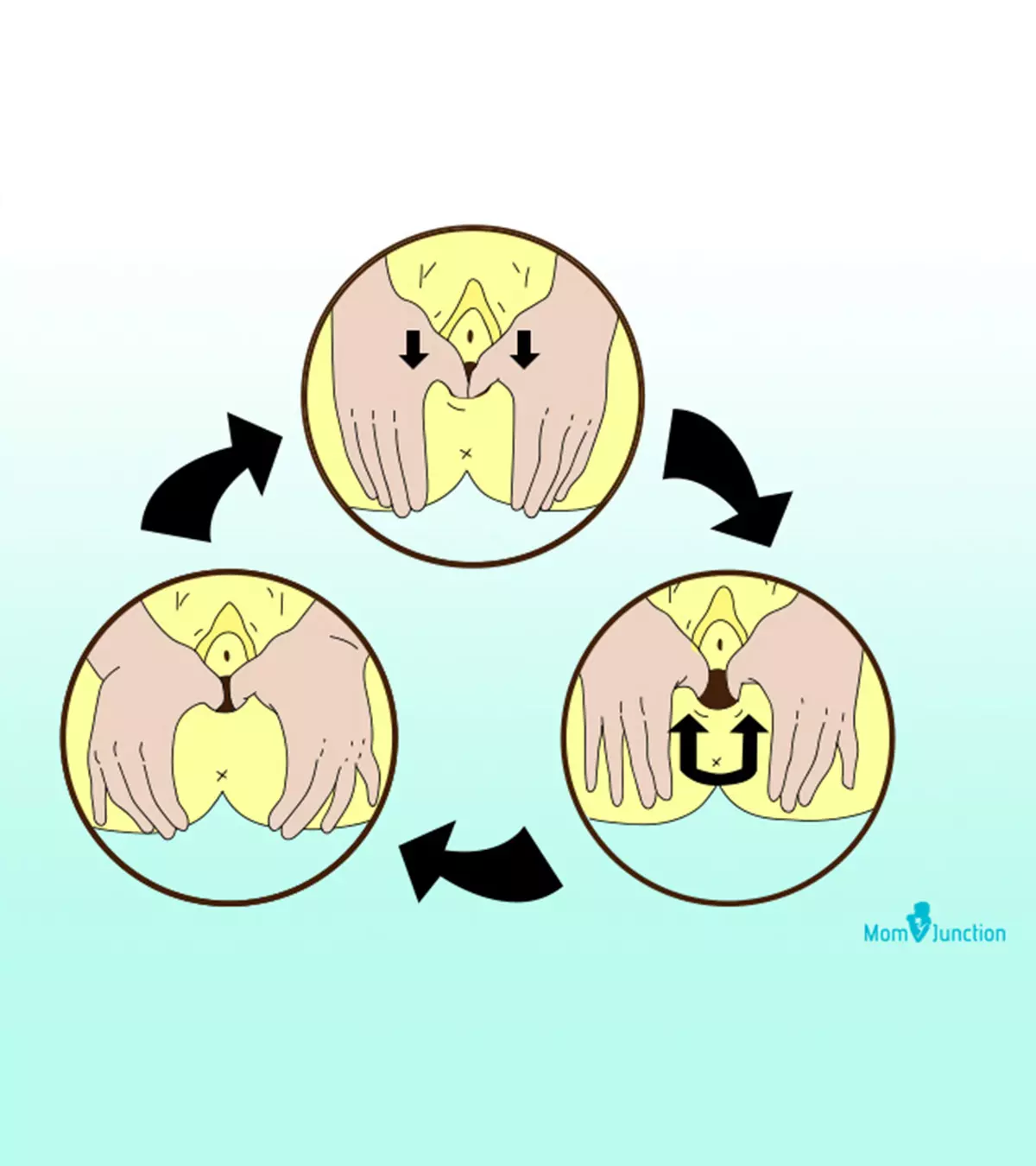
Image: iStock
Delayed cord clamping (DCC) has become a standard practice during child’s birth for its significant benefits. The procedure delays umbilical cord severance by a few minutes after childbirth. According to the WHO, cutting the cord is carried out more than one minute after birth or when the umbilical cord has stopped pulsating (1). Delayed cord clamping gives some more time for the beneficial nutrients from the blood in the cord and placenta to travel to the baby (2). Both term and premature infants continue receiving the benefits of this procedure for several days after birth.

However, you should also be aware of some risks of the procedure. Read on to learn more about delayed cord clamping, its benefits, when to avoid it, and how to include it in your birth plan.
Key Pointers
- Delayed cord clamping transfers blood and iron from the maternal circulation to the newborn’s circulation.
- Reduced chances of anemia, need for blood transfusion, prevention of intraventricular hemorrhage, and necrotizing enterocolitis are some significant benefits.
- DCC may increase bilirubin levels leading to jaundice; however, phototherapy can help combat the condition.
- You can include it in your birth plan after consulting your doctor during prenatal visits.
How Does Delayed Cord Clamping Work?

Umbilical cord aids in the transfer of vital nutrients and oxygen from the mother to the baby in utero. After the baby is born, though they do not need the umbilical cord, the cord and the placenta may have over-retained blood and nutrients that may help the baby in more than one way (3).
Until a few years ago, the umbilical cord was typically cut immediately after a baby was born. However, with increasing evidence about delayed cord clamping, a baby’s umbilical cord is clamped and cut after it turns white or stops pulsating. As the blood drains out, the doctor may be able to feel the stopped pulsation by simply holding the cord in their fingers (4).
After midwives cut the cord, they conduct routine check-ups of the baby. Additionally, if you wish to establish skin-to-skin contact, you can do it before the umbilical cord is cut (5).
 Research finds
Research findsWhat Are The Benefits Of Delayed Cord Clamping?
With delayed cord clamping, you are providing several benefits to your newborn.
- Reduces anemia risk
Delaying cord clamping by one to three minutes can help the baby get at least 80-100ml of additional blood from the placenta into circulation (6). The extra blood flow from DCC may add about 40-50mg/kg of iron to the baby’s body. This additional iron can significantly reduce the risk of iron deficiency anemia and associated risks (2).
- Increases blood volume and RBC count
Delayed cord clamping can help increase the infant’s RBC volume by 60% and the blood volume by 30% (2). The extra blood allows the baby to adapt to the changes and life outside the womb.
- Limits the need for blood transfusions in the future
Research outlines that preterm babies may be more likely to need blood transfusions.
Delayed cord clamping in preterm babies who do not require immediate resuscitation can significantly reduce their need for blood transfusion (7).
- Alleviates the risk of bleeding in the brain
Research indicates that preterm babies are at a higher risk of intraventricular hemorrhageiA form of bleeding into the ventricles that are surrounded by the human brain and often observed in premature babies . Clinical studies have shown that delayed cord clamping has improved the autoregulation of cerebral function, reducing the chances of brain bleeding in newborns (8).
- Improves myelin content
Researchers have observed that when monitored at 12th months old, babies who had delayed cord clamping exhibited higher myeliniAn insulating sheath that surrounds nerve cells for quick transmission of electric impulses content in the brain regions associated with sensory, visual, and motor functions of the body. It indicates that delayed cord clamping improves the baby’s overall development significantly (9).
- Lowers the incidence of necrotizing enterocolitis
In preterm infants, there is a high risk of necrotizing enterocolitis, a life-threatening condition characterized by intestinal inflammation, intestinal perforation, and bacterial leakage into the abdomen. Delayed cord clamping reduces the incidence of necrotizing enterocolitis in preterm infants (10).
Are There Any Disadvantages Of Delayed Cord Clamping?
Despite the benefits, delayed cord clamping holds some disadvantages, and being aware of them helps you make an informed decision.
- Increased bilirubin levels
The extra blood that the baby receives may break down to form bilirubini. Research highlights that bilirubiniA yellowish compound produced by the liver to break down old red blood cells and aid in the digestion of food . is harmful to fetal development and brain functioning. DCC may lead to neonatal jaundice. PhototherapyiAn intentional exposure of babies’ skin to bright light for the treatment of jaundice since their birth helps in treating babies with increased bilirubin levels (11).

- Respiratory distress in term and preterm infants
A full-term baby will have fluid filled in the lung. As soon as they begin breathing, some fluid gets pushed out, absorbed, or coughed out by the baby. The excess blood volume from DCC may reduce the free space available to accommodate this fluid. Some studies say this may cause respiratory distress, but it may be far-fetched to say that it causes breathing trouble in the baby (11).
There are speculations that DCC can cause breathing difficulties in preterm infants as their respiratory system may be underdeveloped. However, the available research is inconclusive (11).

 Point to consider
Point to considerCan You Add DCC As Part Of Your Birth Plan?
The benefits of delayed cord clamping significantly outweigh the risks associated with it. Hence, if you are approaching your delivery date, you can consider opting for DCC after getting your healthcare provider’s consent.
Do note the procedure can be subject to various factors noted by the doctor during childbirth. For instance, your doctor may abandon delayed cord clamping and clamp the cord immediately if your baby is born sick and needs prompt medical attention. The doctor will suggest whether it is safe based on your and your baby’s health during childbirth.
 Did you know?
Did you know?Frequently Asked Questions
1. Can I have delayed cord clamping with a cesarean section?
Small-scale research has shown that it is safe for you to have a cesarean section and delayed cord clamping for your baby (12).
2. Can I preserve blood from the cord for medical research?
It is possible to preserve the blood from the cord after delayed cord clamping for medical research. However, delayed cord clamping may reduce the blood volume needed for collection. The bank and the hospital team need to collect the blood as soon as possible for a higher volume (13)
3. Does delayed cord clamping increase birth weight?
The current research does not support or establish any link between cord clamping and birth weight.
4. Can I have delayed cord clamping if I am HIV-positive?
The WHO recommends that all mothers, including HIV-positive mothers, can opt for delayed cord clamping. The placental blood transfer during DCC is the same as during pregnancy and it is not found to increase the baby’s risk of contracting HIV from the mother (14).
5. What is the difference between delayed cord clamping and milking the cord?
Delayed cord clamping passively transfers blood from the cord and placenta to the baby without any physical intervention from medical professionals. In the milking of the cord, medical professionals use their fingers to push the blood out of the cord for a quicker and more efficient transfer. It is a relatively safe technique to save time (15).
6. What is the difference between delayed cord clamping and cord blood banking?
In delayed cord clamping, cutting the umbilical cord is delayed by a few minutes. It acts like a physiological blood transfusion for the newborn providing enough iron reserves for the initial days. Whereas, cord blood banking is when blood is collected and stored from the umbilical cord after delivery. The blood is collected right after the umbilical cord is cut. Cord blood is a rich source of stem cells that may be used to treat certain serious diseases. It is usually donated to public or private cord blood banks. Cord blood can be life saving for someone requiring a stem cell transplant (1) (16).
Doctors and obstetricians across the globe promote delayed cord clamping. Several reputed associations, such as WHO and ACOG, support delayed cord clamping for its evidence-based benefits for the baby. It carries minimal risks, and the benefits outweigh the risks considerably. Discuss it with your doctor during prenatal visits and tell them if you wish to include DCC protocol in your birth plan. (17)
Infographic: When To Avoid Delayed Cord Clamping For Your Baby
Despite the proven advantages of delayed cord clamping, there may be some health conditions where the doctor may recommend opting out of the procedure for the health of the baby and the mother. Check out this infographic, where we outline various conditions of pregnancy where delayed cord clamping might do more harm than good.
Some thing wrong with infographic shortcode. please verify shortcode syntax
Discover the benefits of delayed cord clamping for newborns. Discover how it can improve their health and well-being from a neonatalogist in this video.
References
- Delayed umbilical cord clamping for improved maternal and infant health and nutrition outcomes.
https://iris.who.int/bitstream/handle/10665/148793/9789241508209_eng.pdf - Delayed Cord Clamping.
https://americanpregnancy.org/healthy-pregnancy/labor-and-birth/delayed-cord-clamping/ - 4 Reasons to Consider Delayed Cord Clamping.
https://www.muhealth.org/our-stories/4-reasons-consider-delayed-cord-clamping#:~:text=Delayed%20cord%20clamping%20means%20that - Delayed (optimal) cord clamping.
https://www.tommys.org/pregnancy-information/giving-birth/delayed-cord-clamping-optimal#:~:text=It%20is%20normal%20practice%20to - Skin-to-Skin Bonding (Kangaroo Care).
https://www.uchicagomedicine.org/conditions-services/pregnancy-childbirth/postpartum-recovery-bonding/skin-to-skin-kangaroo-care#:~:text=If%20you%20choose%20delayed%20cord - Raju Tonse NK and Nalini Singhal; (2012); Optimal timing for clamping the umbilical cord after birth.
https://www.ncbi.nlm.nih.gov/pmc/articles/PMC3835342/#:~:text=In%20term%20infants%2C%20one%2Dminute - Lemyre Brigitte et al.; (2015); Minimizing blood loss and the need for transfusions in very premature infants.
https://www.ncbi.nlm.nih.gov/pmc/articles/PMC4699539/ - Vesoulis Zachary A. Steve M. Liao and Amit M. Mathur; (2019); Delayed cord clamping is associated with improved dynamic cerebral autoregulation and decreased incidence of intraventricular hemorrhage in preterm infants.
https://www.ncbi.nlm.nih.gov/pmc/articles/PMC6692745/ - Mercer Judith S. et al.; (2025); The effects of delayed cord clamping on 12-month brain myelin content and neurodevelopment: a randomized controlled trial.
https://pubmed.ncbi.nlm.nih.gov/32702760/#:~:text=Conclusion%3A%20At%2012%20months%20of - Delayed Umbilical Cord Clamping After Birth.
https://www.acog.org/clinical/clinical-guidance/committee-opinion/articles/2025/12/delayed-umbilical-cord-clamping-after-birth - Regenerative medicine.
https://www.aabb.org/news-resources/resources/cellular-therapies/facts-about-cellular-therapies/regenerative-medicine - Sun Meiling et al.; (2017); Delayed umbilical cord clamping in cesarean section reduces postpartum bleeding and the rate of severe asphyxia.
https://pubmed.ncbi.nlm.nih.gov/29714858/ - American College of Obstetricians and Gynecologists and Committee on Obstetric Practice; (2025); Delayed umbilical cord clamping after birth.
https://journals.lww.com/greenjournal/Fulltext/2025/12000/Delayed_Umbilical_Cord_Clamping_After_Birth__ACOG.37.aspx - Delayed clamping of the umbilical cord to reduce infant anemia.
https://iris.who.int/bitstream/handle/10665/120074/WHO_RHR_14.19_eng.pdf;jsessionid=B937EB98AE77EFC0ACF379974F4E29B9?sequence=1 - Katheria
Anup C. et al.; (2015); Umbilical cord milking versus delayed cord clamping in preterm infants. - Cord Blood Banking.
https://my.clevelandclinic.org/health/treatments/23981-cord-blood-banking - Prevalence of Delayed Cord Clamping Among U.S. Hospitals by Facility Characteristics.
https://stacks.cdc.gov/view/cdc/111333/cdc_111333_DS1.pdf - What You Should Know About Delayed Cord Clamping After Birth.
https://health.clevelandclinic.org/what-you-should-know-about-delayed-cord-clamping-after-birth#:~:text=Bilirubin%20can%20be%20harmful%20for
Delayed Cord Clamping: Newborn Health Benefits
Watch our video to learn how delayed cord clamping boosts your baby’s health—from reducing anemia risk to enhancing brain development. Dive in and discover expert insights and benefits. Watch now!
Community Experiences
Join the conversation and become a part of our nurturing community! Share your stories, experiences, and insights to connect with fellow parents.
Read full bio of Dr. Swati Chitnis
Read full bio of Dr. Ritika Shah
Read full bio of Rebecca Malachi
Read full bio of Dr. Joyani Das

















